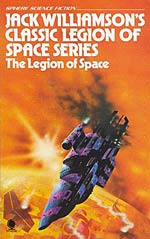
![]() charlesdee
charlesdee
5/8/2012
![]()
Zowie!
When the the last time you finished reading a book and said, "Zowie!"?
I might have said it when I finished Jack Williamson's The Legion of Space had I been twelve years old and read it in 1934, the year it was first serialized in Astounding Stories. I might have uttered an appreciative "zowie" had I read it in book form in 1947, assuming, again, and this always seems to be the crucial bit, that I was around twelve years old. But I just read it in a book club edition published along with two other Wiliamson "League" stories in 1975. Two confessions: I am not twelve years old, and I am not going to read the other two novels.
The "Legion" series exists today as an interesting historical artifact, a sample of what sf was like before the Golden Age that began after World War II. It is also a good example of why the literary establishment -- damn those snobs -- were not inclined to take sf seriously. This is a slambang adventure story -- planet-hopping space opera with the fate of the human race at stake. Can this desperate band of misfits, lifted as characters from The Three Muskateers with a touch of Flastaff thrown in, get the job done? Can they rescue Aldoree!, a heroine whose name appears so often followed by an exclamation point that when one is missing it reads as a typo. Aladoree! who holds the secret to an all-powerful weapon. Aladoree! who is held captive by the grotesque Medusae, gigantic floating things from beyond our universe who fortunately, for mankind's sake, want the secret of Aladoree's weapon badly enough themselves that they don't just kill her and get it over with.
Williamson wrote this when he was twenty five years old, and he published his last Legion novel in 1982. If The Three Muskateers was his inspiration,Star Wars is his progeny. Had The Legion of Space been optioned by Hollywood in the 1930's or '40's, the film would have looked like a Buck Rogers serial, with which, admittedly, it has a lot in common. The sets would have been as stagy as the acting, and the monsters would have looked ridiculous. In fact most of the monsters could not even have been done unless the studio was prepared to pony up for stop motion animation. It was not until the last decades of the 20th century that special effects technology began to catch up with what was called for by sf narratives. But what we got, fifty years after the fact, were the same adolescent fantasies that appeared in the pulps. OK, not true across the board, but look in the movie guide of today's paper -- if anyone still takes the paper.
I am not going to change my rating of The Legion of Space, but I recommend that anyone interested in the history of science fiction give it a read.
http://www.potatoweather.blogspot.com